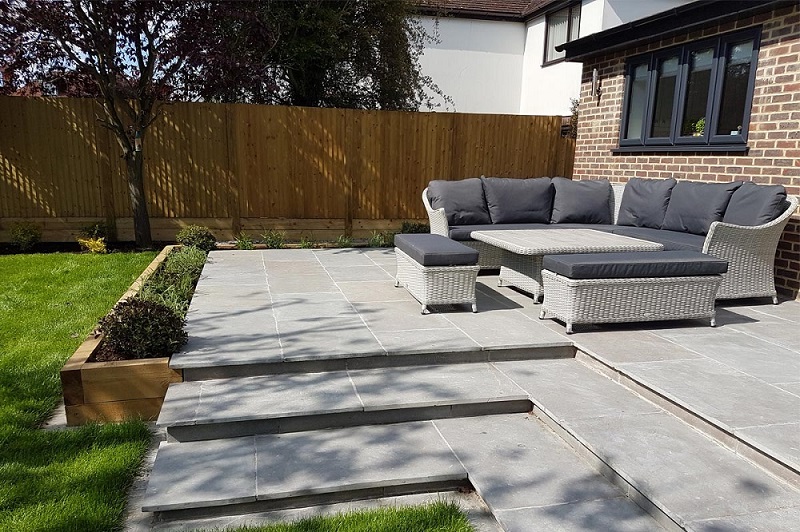Cleaning a natural stone patio needn't be laborious, especially if you follow our recommendations below. We talk you through how to bring the best out of your paving.
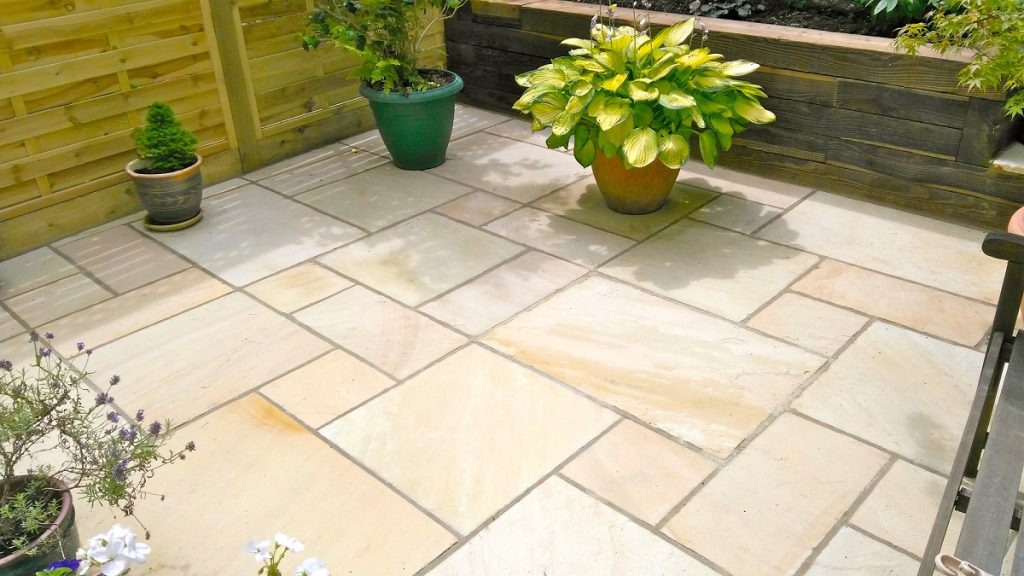
How to clean your patio
Brush or jet wash?
It's perfectly possible to use a bucket of hot water and a stiff brush to remove dirt and detritus. A jet wash is likely to be quicker, but care should be taken when using one.
Choosing your patio cleaner
The most common dirt and stains affecting patios are:
- Marks from organic material such as fallen leaves left to lie and rot on the surface.
- Algae, which adds a green haze to paving stones.
- Oil stains and spills from barbecues.
- "Rust" marks from wooden furniture and decking.
Some of these can be quite stubborn, especially when they have sunk into the stone. We've tried out a large number of cleaners in our time and, for a thorough clean, we recommend Lithofin Outdoor Cleaner. An intensive cleaner, this is probably all you need to bring a patio up to summer-party standard. It's great for natural vegetation, mould, and where leaves have mulched, as well as for many other marks, including light cement stains and efflorescence. It’s quite magical in the results it gives.
For more information on Outdoor Cleaner and on what to choose for different types of stain, consult our guide to patio cleaning products, as specific stains can respond best to cleaners designed specially for them.
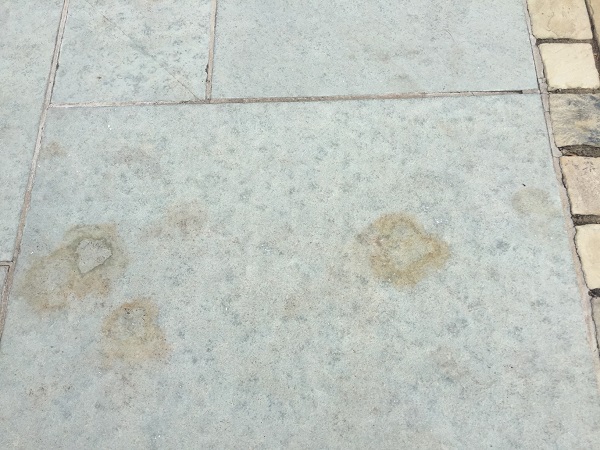
Cleaning a limestone patio
Please note, it is vital that you use the correct chemicals for cleaning limestone or other calcareous stone of any colour.
Cleaning off cement and mortar
Removing mortar stains from paving requires its own careful approach.
Using brick acid
You will also find numerous references on the internet to using brick acid to clean paving. This can, especially in inexperienced hands, have a very deleterious effect on paving, so we always recommend a proprietary cleaning solution.
Professional cleaning services
If you decide to call in a cleaning service, consider something like the DOFF system. It uses steam-heated water in a low-pressure approach without chemicals, relying on heat to kill bacteria and algae within the stone.
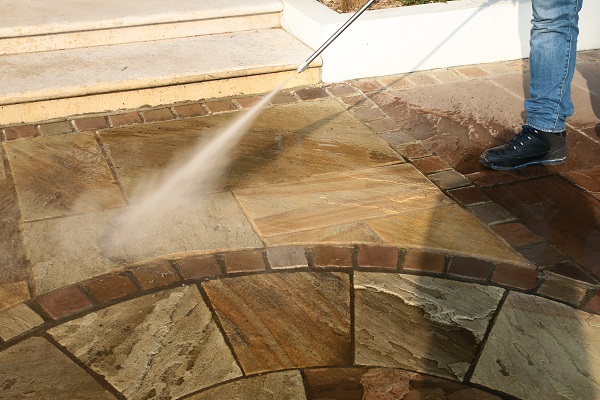
The best way to clean natural stone paving
- Before cleaning, sweep the stone to remove loose dirt and detritus. This is to prevent it acting as an abrasive agent when moved around the surface of the stone, especially by a water jet.
- For any product you have not used before on your natural stone, test it on a small, out-of-the-way area to check it doesn't affect the look of the paving.
- Follow the instructions on the product you use. These can differ dramatically. For example, Lithofin Outdoor Cleaner should be applied with a garden sprayer and left to dwell on the surface for 2-10 hours. Dry Treat Alkaline Cleaner should be applied directly and not allowed to dry on the surface.
Patio maintenance
Once you’ve spent time cleaning your natural stone patio, you don’t really want to do it again in the near future.
Keeping your patio looking its best and reducing the need to clean doesn’t have to take much time. Simple TLC will maintain its condition and looks with minimal effort, and save time and effort in the long run. It’s also a good idea to keep on top of algal growth, so preventing a build-up of micro-organisms that eventually turn any surface slippery, especially in shady areas.
Regular brushing
A quick, firm sweep with a stiff-bristled brush will remove any dried mud or dirt. Done regularly, this also prevents dirt and detritus accumulating in the joints.
This is particularly important in autumn. Leaf fall is the main headache at this time of year because leaves carry a lot of tannins. The main problems arise when you leave leaves to decompose on the paving. After a few months, you'll get stubborn vegetation stains. So it's a good idea to ensure that they aren’t allowed to sit on the paving for a long period.
Taking care of spillages
Drinks, in particular, can damage the surface appearance of stone slabs. Orange juice, wine and coffee, for example, are highly acidic and, if spilt on calcareous stone such as limestone, can cause dull spots. We suggest mats under drinks when they are placed on the slabs. If any spillage does occur, then it’s important to wipe it up straight away using a dry cloth.
Preventative treatment
Treating your paving with Lithofin ALGEX in autumn will help keep it free of green, slippery algae and reduce the need to clean in spring.
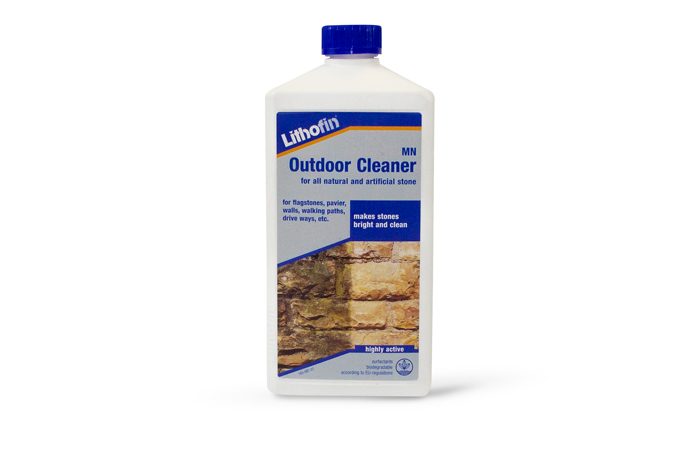
Do a general clean twice a year
As a minimum, we recommend that patios should be cleaned twice a year.
A spring clean with something like Lithofin Outdoor Cleaner removes the dirt accumulated over the winter and gets your garden ready for visitors. A deep cleanse now is likely to take you through to the autumn.
In autumn, clean up after the summer and apply Algex to protect your paving from the weather to come. Cleaning your patio in autumn and limiting algal growth means that there's less to do the following spring.
Other ways to reduce the need to clean your patio
Choosing your paving
If you have not yet laid paving and are investigating maintenance requirements, it’s worth noting that your choice of driveway or patio paving will affect how often it needs to be cleaned.
Choosing a dark-coloured patio reduces maintenance needs, as it won’t show up dirt. A really hard-wearing stone with low porosity will also require less attention as harder stones absorb water and dirt more slowly than softer pavings. Naturally dense stones such as Kota Blue and Kota Brown limestone and Indian sandstone are good choices.
Choosing where to put your patio
Physical surroundings have a major impact on how much effort you have to put into keeping a patio clean. If your garden faces north, it may be damp. This makes it a haven for algae, which cause discolouration to garden patios. Also look around and see how many trees are close by. If not removed, leaves can leave behind prominent stains like those in the picture above - something you may find irritating. Consider whether you'd prefer your patio in a different part of the garden.
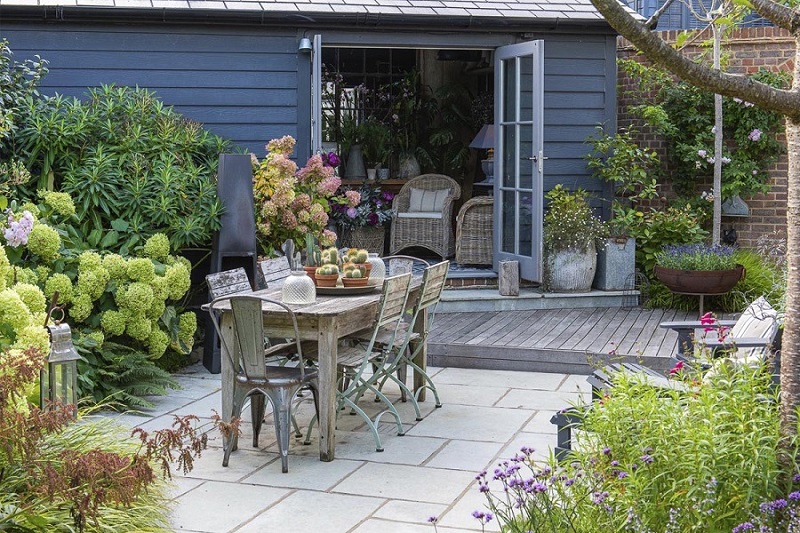
Seal to reduce cleaning
Making the decision on whether to seal paving depends on your circumstances, where your paving is laid, and how your patio is used. For light-coloured and sawn stone, a penetrative sealant makes cleaning much easier without affecting the appearance of the paving.
Take advice
For more specific information on the maintenance of natural stone paving it is always a good idea to take specialist advice. A good stone merchant will be able to give you really good practical advice and help you to avoid the major pitfalls.
Why not visit a showroom and ask one of our expert team to talk you through the best choice of paving for your garden?
Post updated: June 2024


/filters:quality(40)/mediadev/media/homepage/price_right_arrow.svg)
/filters:quality(60)/mediadev/media/menu-pics/menu_banner_mobile.png )
/filters:quality(60)/mediadev/media/menu-pics/all-porcelain.jpg )
/filters:quality(60)/mediadev/media/menu-pics/luxury-italian.jpg )
/filters:quality(60)/mediadev/media/menu-pics/premium-italian.jpg )
/filters:quality(60)/mediadev/media/menu-pics/budget-porcelain.jpg )
/filters:quality(60)/mediadev/media/menu-pics/large-format-porcelain.jpg )
/filters:quality(60)/mediadev/media/menu-pics/wood-effect-porcelain.jpg )
/filters:quality(60)/mediadev/media/menu-pics/porcelain-planks.jpg )
/filters:quality(60)/mediadev/media/menu-pics/porcelain-setts.jpg )
/filters:quality(60)/mediadev/media/menu-pics/browse-all-paving.jpg )
/filters:quality(60)/mediadev/media/menu-pics/stone-paving.jpg )
/filters:quality(60)/mediadev/media/menu-pics/interior-tiles.jpg )
/filters:quality(60)/mediadev/media/menu-pics/stone-effect-porcelain.png )
/filters:quality(60)/mediadev/media/menu-pics/wood-effect-porcelain.png )
/filters:quality(60)/mediadev/media/menu-pics/grey-porcelain.png )
/filters:quality(60)/mediadev/media/menu-pics/beige-porcelain.png )
/filters:quality(60)/mediadev/media/menu-pics/dark-porcelain.png )
/filters:quality(60)/mediadev/media/menu-pics/light-porcelain.png )
/filters:quality(60)/mediadev/media/menu-pics/patio-grout.jpg)
/filters:quality(60)/mediadev/media/menu-pics/primers.jpg)
/filters:quality(60)/mediadev/media/menu-pics/porcelain-blades.jpg)
/filters:quality(90)/mediadev/media/menu-pics/drainage.jpg)
/filters:quality(60)/mediadev/media/menu-pics/cleaners.jpg)
/filters:quality(60)/mediadev/media/menu-pics/all-stone-paving.jpg )
/filters:quality(60)/mediadev/media/menu-pics/all-sawn-paving.jpg )
/filters:quality(60)/mediadev/media/menu-pics/all-riven-paving.jpg )
/filters:quality(60)/mediadev/media/menu-pics/indian-sandstone.jpg )
/filters:quality(60)/mediadev/media/menu-pics/limestone-paving.jpg )
/filters:quality(60)/mediadev/media/menu-pics/granite-paving.jpg )
/filters:quality(60)/mediadev/media/menu-pics/slate-paving.jpg )
/filters:quality(60)/mediadev/media/menu-pics/yorkstone-paving.jpg )
/filters:quality(60)/mediadev/media/menu-pics/stone-pavers.jpg )
/filters:quality(60)/mediadev/media/menu-pics/cobbles-setts.jpg )
/filters:quality(60)/mediadev/media/menu-pics/plank-paving.jpg )
/filters:quality(60)/mediadev/media/menu-pics/paving-circles.jpg )
/filters:quality(60)/mediadev/media/menu-pics/bespoke-paving-1.jpg )
/filters:quality(60)/mediadev/media/menu-pics/edging-stones-1.jpg )
/filters:quality(60)/mediadev/media/menu-pics/prestige-stone.jpg )
/filters:quality(60)/mediadev/media/menu-pics/grey-blue-stone.png)
/filters:quality(60)/mediadev/media/menu-pics/swatch-black-dark.jpg )
/filters:quality(60)/mediadev/media/menu-pics/swatch-buff-beige-white.jpg )
/filters:quality(60)/mediadev/media/menu-pics/sealants.jpg)
/filters:quality(60)/mediadev/media/menu-pics/all-clay-paving.jpg )
/filters:quality(60)/mediadev/media/menu-pics/alpha-clay-pavers.jpg )
/filters:quality(60)/mediadev/media/menu-pics/cottage-garden-clay-pavers.jpg )
/filters:quality(60)/mediadev/media/menu-pics/kessel-garden-clay-pavers.jpg )
/filters:quality(60)/mediadev/media/menu-pics/artisan-clay-pavers.jpg )
/filters:quality(60)/mediadev/media/menu-pics/grey-blue-clay-paver.png )
/filters:quality(60)/mediadev/media/menu-pics/red-brown-clay-pavers.png )
/filters:quality(60)/mediadev/media/menu-pics/beige-buff-clay-pavers.png )
/filters:quality(60)/mediadev/media/menu-pics/composite-decking.jpg )
/filters:quality(60)/mediadev/media/menu-pics/designboard-decking.jpg )
/filters:quality(60)/mediadev/media/menu-pics/classic-designboard.jpg )
/filters:quality(60)/mediadev/media/menu-pics/brushed-designboard.jpg )
/filters:quality(60)/mediadev/media/menu-pics/grooved-designboard.jpg )
/filters:quality(60)/mediadev/media/menu-pics/millboard-decking.jpg )
/filters:quality(60)/mediadev/media/menu-pics/grey-decking.jpg )
/filters:quality(60)/mediadev/media/menu-pics/black-charcoal-decking.jpg)
/filters:quality(60)/mediadev/media/menu-pics/brown-decking.jpg)
/filters:quality(60)/mediadev/media/menu-pics/all-build-deck.png )
/filters:quality(60)/mediadev/media/menu-pics/stone-cladding.jpg )
/filters:quality(60)/mediadev/media/menu-pics/all-garden-walling-1.jpg )
/filters:quality(60)/mediadev/media/menu-pics/facing-bricks.jpg )
/filters:quality(60)/mediadev/media/menu-pics/garden-screening.jpg )
/filters:quality(60)/mediadev/media/menu-pics/menu_Garden_banner_desk.png )
/filters:quality(60)/mediadev/media/menu-pics/all-steps-coping.jpg )
/filters:quality(60)/mediadev/media/menu-pics/stone-garden-steps.jpg )
/filters:quality(60)/mediadev/media/menu-pics/sawn-steps.jpg )
/filters:quality(60)/mediadev/media/menu-pics/riven-steps.jpg )
/filters:quality(60)/mediadev/media/menu-pics/yorkstone-steps.jpg )
/filters:quality(60)/mediadev/media/menu-pics/bespoke-steps.jpg )
/filters:quality(60)/mediadev/media/menu-pics/porcelain-steps.jpg )
/filters:quality(60)/mediadev/media/menu-pics/off-the-shelf.jpg )
/filters:quality(60)/mediadev/media/menu-pics/stone-coping.jpg )
/filters:quality(60)/mediadev/media/menu-pics/sawn-coping.jpg )
/filters:quality(60)/mediadev/media/menu-pics/riven-coping.jpg )
/filters:quality(60)/mediadev/media/menu-pics/yorkstone-coping.jpg )
/filters:quality(60)/mediadev/media/menu-pics/bespoke-coping.jpg )
/filters:quality(60)/mediadev/media/menu-pics/stone-pier-caps.jpg )
/filters:quality(60)/mediadev/media/menu-pics/porcelain-coping.jpg )
/filters:quality(60)/mediadev/media/menu-pics/all-bespoke-services.jpg )
/filters:quality(60)/mediadev/media/menu-pics/bespoke-paving-2.jpg )
/filters:quality(60)/mediadev/media/menu-pics/bespoke-steps-1.jpg )
/filters:quality(60)/mediadev/media/menu-pics/bespoke-coping-1.jpg )
/filters:quality(60)/mediadev/media/menu-pics/edge-profiles.jpg )
/filters:quality(60)/mediadev/media/menu-pics/masonry-services.jpg )
/filters:quality(60)/mediadev/media/menu-pics/deluxe-pergolas.jpg )
/filters:quality(60)/mediadev/media/menu-pics/proteus-pergolas.jpg )
/filters:quality(60)/mediadev/media/menu-pics/corten_planter_menu.png )
 Trade Discount Available
Trade Discount Available FREE Nationwide Delivery
FREE Nationwide Delivery Nationwide Showrooms
Nationwide Showrooms Live Stock Levels
Live Stock Levels Split Packs Available
Split Packs Available
